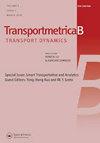高速公路匝道上连接自动车辆的多车道并线策略
IF 3.4
2区 工程技术
Q2 TRANSPORTATION
引用次数: 4
摘要
本文章由计算机程序翻译,如有差异,请以英文原文为准。
Multi-lane-merging strategy for connected automated vehicles on freeway ramps
Most studies assume the ramp to be a single lane regardless of the possibility of multiple lanes on a freeway ramp. This assumption limits the application of previous ramp metering strategies in the real world. Therefore, this paper proposes a strategy for a centralized controller to efficiently merge connected automated vehicles from a multiple-lane ramp. The proposed strategy aims to allow vehicles from different lanes to pass through the conflict point with the objective of minimum delay and fuel consumption. Numerical experiments are carried out to compare the proposed strategy with first-in-first-out (FIFO) and Vissim built-in strategies. Simulation results indicate that the proposed strategy can reduce more delay than FIFO and Vissim-based strategies. Furthermore, the proposed strategy is also found to be the most reliable in various scenarios with different traffic demand splits, safe headways, and numbers of lanes.
求助全文
通过发布文献求助,成功后即可免费获取论文全文。
去求助
来源期刊

Transportmetrica B-Transport Dynamics
TRANSPORTATION SCIENCE & TECHNOLOGY-
CiteScore
5.00
自引率
21.40%
发文量
53
期刊介绍:
Transportmetrica B is an international journal that aims to bring together contributions of advanced research in understanding and practical experience in handling the dynamic aspects of transport systems and behavior, and hence the sub-title is set as “Transport Dynamics”.
Transport dynamics can be considered from various scales and scopes ranging from dynamics in traffic flow, travel behavior (e.g. learning process), logistics, transport policy, to traffic control. Thus, the journal welcomes research papers that address transport dynamics from a broad perspective, ranging from theoretical studies to empirical analysis of transport systems or behavior based on actual data.
The scope of Transportmetrica B includes, but is not limited to, the following: dynamic traffic assignment, dynamic transit assignment, dynamic activity-based modeling, applications of system dynamics in transport planning, logistics planning and optimization, traffic flow analysis, dynamic programming in transport modeling and optimization, traffic control, land-use and transport dynamics, day-to-day learning process (model and behavioral studies), time-series analysis of transport data and demand, traffic emission modeling, time-dependent transport policy analysis, transportation network reliability and vulnerability, simulation of traffic system and travel behavior, longitudinal analysis of traveler behavior, etc.
 求助内容:
求助内容: 应助结果提醒方式:
应助结果提醒方式:


